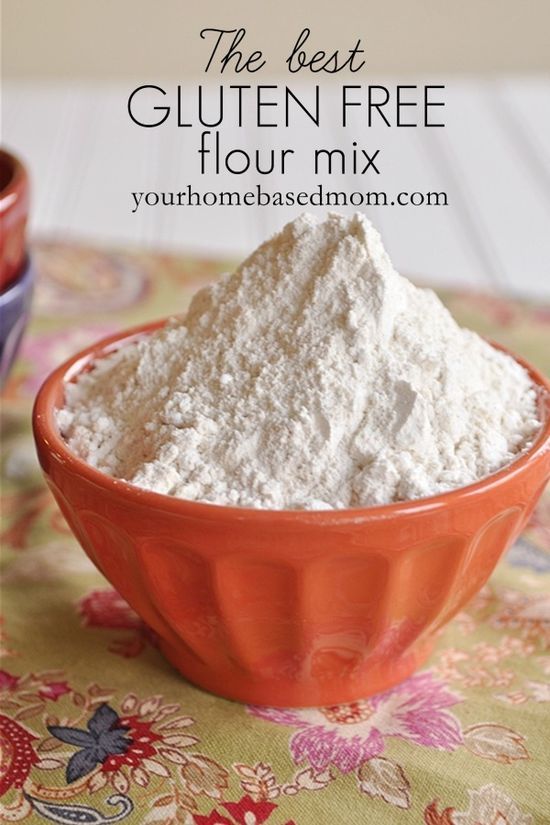Cup for cup, make your own Gluten Free Flour Mix!

Š’Ā
Cup for cup, make your own Gluten Free Flour Mix! 1 C each of white rice flour, coconut flour, oat flour, and tapioca flour/starch, 1/4 C cornstarch, and 3.5 tsp xantham gum. Mix well and store in airtight container. Use cup for cup in any recipe that calls for flour.
As you know, we like to make our own flour mixes in this house. Any of our recipes that call for a gluten-free all-purpose flour mix are based on a 40/60 ratio: 40% whole grain and 60% white flours/starches. Once you figure out your flours, and you shake up a big container of it? You have flour for any recipe you want to create. However, we havenŠ²Š‚ā„¢t been able to show you exactly what we mean until now. HereŠ²Š‚ā„¢s me, being goofy again, explaining how to make a gluten-free all-purpose flour mix. (We have one on the whole-grain mix coming soon.)
In the mix I demonstrated here, we used 200 grams of sorghum flour, 200 grams of millet flour, 300 grams of sweet rice flour, and 300 grams of potato starch. (ThatŠ²Š‚ā„¢s for 1000 grams of flour mix. If you want twice that, simply multiply everything x 2. If you want 5 times that amount of flour, simply multiply everything x 5.) ThatŠ²Š‚ā„¢s the combination I have been using lately, mostly because I tried to simplify this for you, using as few flours as possible. Remember that wheat flour is not all gluten protein. ItŠ²Š‚ā„¢s part protein and part starches. ThatŠ²Š‚ā„¢s why we mix whole-grain flours (most of which are very high in protein) with starches (not much nutritional value but they help make the flour mix hold together and make it look white enough to make familiar-looking baked goods). But thatŠ²Š‚ā„¢s just the flour mix we use here. This is really important to us: we want you to make your own flour mix. Please donŠ²Š‚ā„¢t think of us this as our flour mix. Make it your own. We are happy as heck that the percentages of whole grain flours to white flours works in gluten-free baking. Now, make your own. In case you were wondering, here are the gluten-free flours available to you, broken down by categories: WHOLE GRAIN FLOURS brown rice flour buckwheat flour corn flour mesquite flour millet flour oat flour quinoa flour sorghum flour sweet potato flour teff flour WHITE FLOURS/STARCHES arrowroot flour cornstarch potato flour potato starch sweet rice flour tapioca flour white rice flour NUT FLOURS almond flour chestnut flour coconut flour hazelnut flour BEAN FLOURS fava bean flour garbanzo bean flour kinako (roasted soy bean) flour See how many choices we have? Now, as you can see, there are more categories than whole-grain flours and white flours. The nut flours and bean flours are their own categories. However, if I add some to the gluten-free all-purpose flour mix, I add them as whole grains. (Technically, sweet potato isnŠ²Š‚ā„¢t a grain but we put it in that category.) Why? Because theyŠ²Š‚ā„¢re so high in protein. However, understand that they work differently than sorghum or millet. I really donŠ²Š‚ā„¢t like the bean flours. To me, they always taste like beans. The exception for me is the roasted soy bean flour, which IŠ²Š‚ā„¢m loving in cookies lately. However, you might love garbanzo flour. Add it as a whole-grain flour in this mix. I really love almond flour in crumbles and bready things. However, remember that the nut flours are full of good fats, so they will throw off the ratio of your baked goods. Recently, I made a pie crust that just didnŠ²Š‚ā„¢t work. Frustrated, I kept puzzling as to what happened. Then I remembered I had added some almond flour to the mix and that mean the crust had too much fat. What we like to do is make the gluten-free all-purpose flour mix with the whole-grain flours and white flours. Then, if I want a specific taste? IŠ²Š‚ā„¢ll add almond flour as part of the total weight of flour in a recipe. Or a bit of roasted soy flour. I play. So you can make a mix based on what you like, what you need, and what you can afford. Allergic to rice? Make a mix with millet, sorghum, arrowroot, and potato starch. Some of those whole-grain flours not available where you live? Use brown rice, corn flour, cornstarch, and white rice. You want to make up a mix based on what you have in the kitchen that moment? Go for it. Of course, itŠ²Š‚ā„¢s not that simple. Each of the flours absorbs water differently. (Coconut flour sucks all the moisture out of a baked good, which is why it annoys me.) Some flours have a particularly strong taste Š²Š‚ā€¯ like mesquite or quinoa Š²Š‚ā€¯ so you want to use them in small doses. But youŠ²Š‚ā„¢ll find your way. Keep playing. This is really all about playing. (Also, remember this: if you want to convert your favorite gluten recipe gluten-free? Start by subbing 140 grams of this flour mix for every 1 cup of gluten AP flour.) Start baking!